

Cornerstone.
All Things Distributed - All Things Distributed. Home » OpenStack Open Source Cloud Computing Software. Git. Now that you have Git on your system, you’ll want to do a few things to customize your Git environment. You should have to do these things only once; they’ll stick around between upgrades. You can also change them at any time by running through the commands again. Git comes with a tool called git config that lets you get and set configuration variables that control all aspects of how Git looks and operates. These variables can be stored in three different places: /etc/gitconfig file: Contains values for every user on the system and all their repositories. On Windows systems, Git looks for the .gitconfig file in the $HOME directory (%USERPROFILE% in Windows’ environment), which is C:\Documents and Settings\$USER or C:\Users\$USER for most people, depending on version ($USER is %USERNAME% in Windows’ environment).
#dogfeet - progit. GitHub의 CIO인 schacon이 쓴 progit 번역을 완료했습니다.
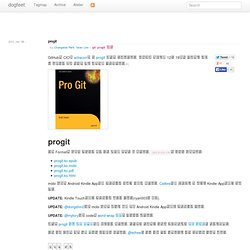
Git for Computer Scientists. Abstract Quick introduction to git internals for people who are not scared by words like Directed Acyclic Graph.
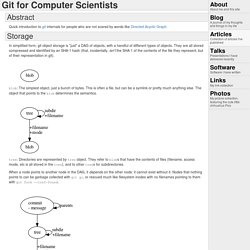
Storage In simplified form, git object storage is "just" a DAG of objects, with a handful of different types of objects. They are all stored compressed and identified by an SHA-1 hash (that, incidentally, isn't the SHA-1 of the contents of the file they represent, but of their representation in git). blob: The simplest object, just a bunch of bytes. Tree: Directories are represented by tree object. When a node points to another node in the DAG, it depends on the other node: it cannot exist without it. LiveJournal. LiveJournal was started on April 15, 1999 by American programmer Brad Fitzpatrick as a way of keeping his high school friends updated on his activities.[8] In January 2005, blogging software company Six Apart purchased Danga Interactive, the company that operated LiveJournal, from Fitzpatrick.
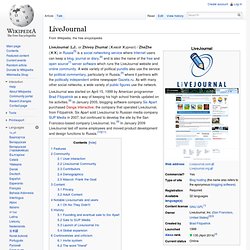
Six Apart sold LiveJournal to Russian media company SUP Media in 2007, but continued to develop the site by the San Francisco-based company LiveJournal, Inc.[9] In January 2009 LiveJournal laid off some employees and moved product development and design functions to Russia.[10][11] Features[edit] The unit of social networking on LiveJournal is quaternary (with four possible states of connection between one user and another).
Two users can have no relationship, they can list each other as friends mutually, or either can "friend" the other without reciprocation. Cloud computing. Cloud computing metaphor: For a user, the network elements representing the provider-rendered services are invisible, as if obscured by a cloud.

Cloud computing is a computing term or metaphor that evolved in the late 1990s, based on utility and consumption of computer resources. Cloud computing involves application systems which are executed within the cloud and operated through internet enabled devices. GitHub. Platform as a service. Platform as a service (PaaS) is a category of cloud computing services that provides a computing platform and a solution stack as a service.[1] Along with software as a service (SaaS) and infrastructure as a service (IaaS), it is a service model of cloud computing.
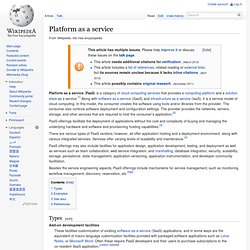
In this model, the consumer creates the software using tools and/or libraries from the provider. The consumer also controls software deployment and configuration settings. The provider provides the networks, servers, storage, and other services that are required to host the consumer's application.[2] PaaS offerings facilitate the deployment of applications without the cost and complexity of buying and managing the underlying hardware and software and provisioning hosting capabilities.[3] Cloud. Premier Cloud Hosting. Infrastructure as a Service.
Heroku. History[edit] The June 2012 North American derecho caused many applications hosted by Heroku to go offline.
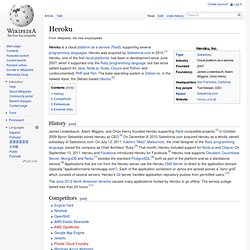
Joyent. Joyent Inc is a software and services company based in San Francisco, California.

The company specializes in application virtualization and cloud computing. Textpattern. Textpattern is an open source content management system originally developed by Dean Allen.

While it is often listed among weblogging tools, its aim is to be a general-purpose content management system suitable for deployment in many contexts. Textpattern is written in PHP using a MySQL database backend. The current stable version is Textpattern 4.5.5.[1] Textpattern CMS A flexible, elegant and easy-to-use content management system. Joyent - Home. Www.joyent.com/content/05-developers/01-resources/22-smartos-datasheet/datasheet-smartos.pdf. Cloud computing. In common usage, the term "the cloud" is essentially a metaphor for the Internet.[1] Marketers have further popularized the phrase "in the cloud" to refer to software, platforms and infrastructure that are sold "as a service", i.e. remotely through the Internet.
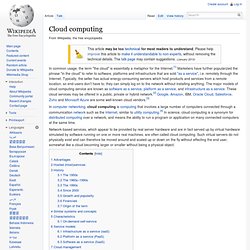
Typically, the seller has actual energy-consuming servers which host products and services from a remote location, so end-users don't have to; they can simply log on to the network without installing anything. The Leading Hadoop Community Event. 큐브리드. OpenFlow. Description[edit] OpenFlow enables remote controllers to determine the path of network packets through the network of switches.
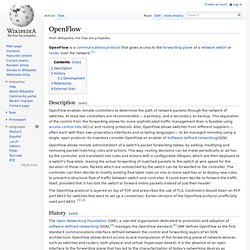
At least two controllers are recommended — a primary, and a secondary as backup. This separation of the control from the forwarding allows for more sophisticated traffic management than is feasible using access control lists (ACLs) and routing protocols. Also, OpenFlow allows switches from different suppliers — often each with their own proprietary interfaces and scripting languages — to be managed remotely using a single, open protocol. Its inventors consider OpenFlow an enabler of Software defined networking(SDN). OpenFlow allows remote administration of a switch's packet forwarding tables, by adding, modifying and removing packet matching rules and actions.
The OpenFlow protocol is layered on top of TCP, and prescribes the use of TLS. Flynn - Open source Platform as a Service powered by Docker. Kinetic Open Storage Documentation Wiki - Kinetic - developers.seagate.com. Kinetic Child pages Pages. ArkOS. Web Hosting, Domains, VPS, Dedicated and WordPress Hosting - DreamHost. Squid (software) Squid was originally designed to run on Unix-like systems.
The Windows port was maintained up to version 2.7 but more current versions are not being developed.[5] Released under the GNU General Public License, Squid is free software. Squid was originally developed as the Harvest object cache,[6] part of the Harvest project at the University of Colorado Boulder.[7][8] Further work on the program was completed at the University of California, San Diego and funded via two grants from the National Science Foundation.[9] Duane Wessels forked the "last pre-commercial version of Harvest" and renamed it to Squid to avoid confusion with the commercial fork called Cached 2.0, which became NetCache.[10][11] Squid version 1.0.0 was released in July 1996.[10] Squid is now developed almost exclusively through volunteer efforts. The above setup—caching the contents of an unlimited number of webservers for a limited number of clients—is the classical one.
Squid can run on the following operating systems: